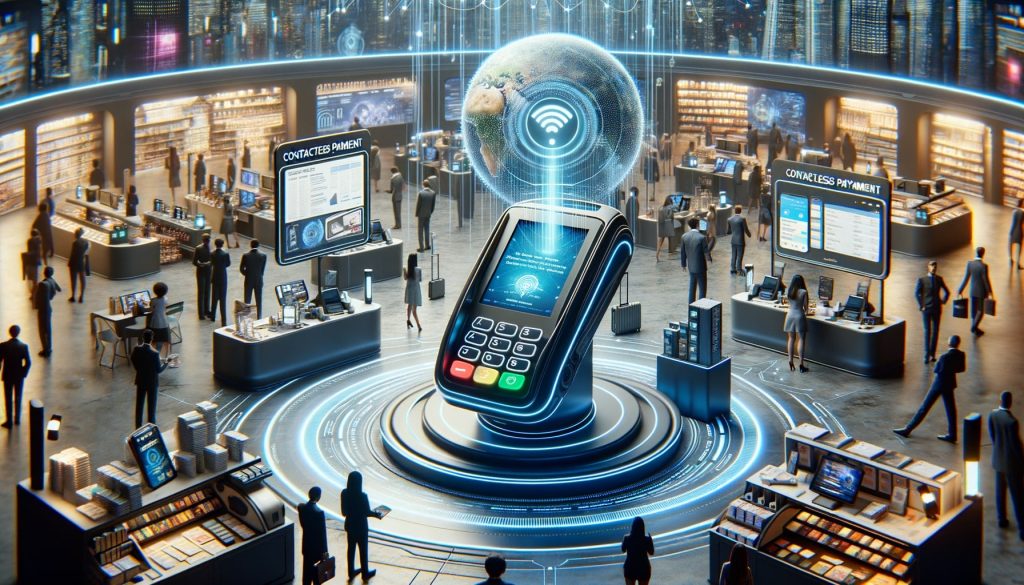
By Manoj Bhatt October 16, 2024
In today’s fast-paced and digital world, contactless payments have become increasingly popular among consumers. With the rise of mobile wallets and the convenience they offer, businesses need to adapt to this new payment method to stay competitive. This comprehensive guide will walk you through the process of making your business ready for contactless payments, covering everything from assessing your readiness to integrating it into your existing point of sale system.
What Are Contactless Payments?
Contactless payments are a method of payment that allows consumers to make purchases by tapping a credit card, debit card, or smartphone near a point-of-sale (POS) terminal equipped with near-field communication (NFC) technology. Unlike traditional payments where the card or device needs to be inserted or swiped, contactless payments require only proximity to the terminal.
How Contactless Payments Work
Contactless payments use NFC technology to transmit encrypted payment data between the payment terminal and the card or mobile device. This exchange happens in a matter of seconds, making it faster than other payment methods. The process involves:
- Initiating Payment: The customer taps their contactless card or device near the POS terminal.
- Transaction Validation: The terminal reads the payment data and sends it to the payment processor.
- Approval: The payment processor authorizes the transaction, which is then confirmed on the terminal screen.
Popular Forms of Contactless Payments

Contactless payments can be made through various methods, including:
- Contactless Cards: Credit or debit cards equipped with NFC technology, identifiable by the wave-like symbol.
- Mobile Wallets: Smartphone-based payment apps such as Apple Pay, Google Pay, and Samsung Pay that store card information and allow payment through a tap.
- Wearable Devices: Smartwatches and fitness trackers like Fitbit or Apple Watch that can store payment information and facilitate contactless payments.
Assessing Your Business’s Readiness for Contactless Payments
Before diving into contactless payments, it’s crucial to assess your business’s readiness for this payment method. Start by evaluating your current payment infrastructure and determining if it can support contactless payments. Consider factors such as the age of your point of sale system, the compatibility of your hardware, and the capabilities of your payment processor. If your current system is outdated or incompatible, it may be time to upgrade to a more modern solution.
Next, analyze your customer base and their preferences. Conduct surveys or gather feedback to understand if your customers are interested in using contactless payments. This will help you gauge the demand and prioritize your efforts accordingly. Additionally, consider the nature of your business and the types of transactions you typically handle. If you frequently process small-value transactions, contactless payments can significantly speed up the checkout process.
Choosing the Right Contactless Payment Solution for Your Business

Once you’ve determined that your business is ready for contactless payments, the next step is to choose the right payment solution. There are several options available, including mobile wallets, contactless cards, and wearable devices. Each has its own advantages and considerations, so it’s essential to select the one that aligns with your business needs and customer preferences.
Mobile wallets, such as Apple Pay and Google Pay, are increasingly popular among consumers. They allow customers to store their payment information securely on their smartphones and make payments by simply tapping their device on a contactless-enabled terminal. Mobile wallets offer convenience and security, making them an attractive option for businesses.
Contactless cards, on the other hand, are traditional payment cards with an embedded chip that enables contactless payments. These cards can be used by customers who prefer not to use mobile wallets or do not have a compatible device. Contactless cards are widely accepted and offer a seamless payment experience.
Wearable devices, such as smartwatches and fitness trackers, are also gaining traction as contactless payment methods. These devices allow customers to make payments by simply tapping their wrist on a contactless terminal. While not as widely adopted as mobile wallets or contactless cards, wearable devices offer a unique and convenient payment experience.
Consider your target audience and their preferences when choosing the right contactless payment solution for your business. Offering multiple options can cater to a broader customer base and increase customer satisfaction.
Setting Up Contactless Payment Infrastructure: Step-by-Step Guide

Once you’ve chosen the right contactless payment solution, it’s time to set up the necessary infrastructure. Here is a step-by-step guide to help you through the process:
- Upgrade your point of sale system: Ensure that your point of sale system supports contactless payments. If not, consider upgrading to a modern system that is compatible with contactless technology.
- Install contactless-enabled terminals: Contact your payment processor or merchant services provider to obtain contactless-enabled terminals. These terminals can accept payments from mobile wallets, contactless cards, and wearable devices.
- Train your staff: Educate your staff on how to process contactless payments and troubleshoot any issues that may arise. Ensure they are familiar with the different contactless payment methods and can assist customers in using them.
- Test the system: Before fully implementing contactless payments, conduct thorough testing to ensure that the system is functioning correctly. Test various payment scenarios and troubleshoot any issues that may arise.
- Update signage and marketing materials: Display clear signage at your point of sale to inform customers that contactless payments are accepted. Update your marketing materials, website, and social media platforms to promote this new payment option.
Ensuring Security and Fraud Prevention in Contactless Payments

While contactless payments offer convenience, it’s crucial to prioritize security and fraud prevention. Implement the following measures to safeguard your business and customers:
- Encryption and tokenization: Ensure that your payment system encrypts sensitive customer data and replaces it with tokens. This adds an extra layer of security and prevents unauthorized access to payment information.
- Two-factor authentication: Consider implementing two-factor authentication for mobile wallet transactions. This requires customers to provide an additional verification method, such as a fingerprint or facial recognition, to authorize the payment.
- Regular software updates: Keep your point of sale system and payment terminals up to date with the latest software updates. These updates often include security patches and bug fixes that protect against vulnerabilities.
- Fraud detection tools: Invest in fraud detection tools that can identify suspicious transactions and flag potential fraudulent activity. These tools use advanced algorithms to analyze transaction patterns and detect anomalies.
- Staff training: Educate your staff on common fraud prevention techniques and how to identify potential fraudulent transactions. Encourage them to be vigilant and report any suspicious activity immediately.
By implementing these security measures, you can ensure that contactless payments are safe and secure for both your business and your customers.
Educating Your Staff and Customers about Contactless Payments
To successfully integrate contactless payments into your business, it’s essential to educate both your staff and customers about this new payment method. Here are some strategies to consider:
- Staff training: Provide comprehensive training to your staff on how to process contactless payments, troubleshoot issues, and address customer questions. Ensure they are familiar with the different contactless payment methods and can confidently assist customers.
- Customer education materials: Create informative materials, such as brochures or posters, that explain the benefits and process of using contactless payments. Display these materials at your point of sale and other high-traffic areas to educate customers.
- In-store demonstrations: Conduct in-store demonstrations to showcase how contactless payments work. Encourage customers to try it themselves and provide assistance if needed. This hands-on experience can alleviate any concerns or hesitations they may have.
- Online tutorials and FAQs: Create online tutorials and frequently asked questions (FAQs) on your website or social media platforms. These resources can help customers understand how to use contactless payments and address common queries.
- Staff incentives: Motivate your staff to promote contactless payments by offering incentives or rewards for successfully encouraging customers to use this payment method. This can help drive adoption and create a positive customer experience.
By educating both your staff and customers, you can ensure a smooth transition to contactless payments and maximize its benefits for your business.
Integrating Contactless Payments into Your Existing Point of Sale (POS) System

Integrating contactless payments into your existing point of sale system is crucial for a seamless customer experience. Follow these steps to ensure a smooth integration:
- Check compatibility: Verify that your current point of sale system is compatible with contactless payments. If not, consult with your payment processor or merchant services provider to explore integration options.
- Update software: Ensure that your point of sale software is up to date and supports contactless payments. If necessary, install any required updates or patches to enable this functionality.
- Configure payment settings: Access your point of sale system’s settings and configure the payment options to include contactless payments. This may involve enabling specific payment types or activating contactless functionality.
- Test transactions: Conduct test transactions to ensure that contactless payments are processed correctly and seamlessly integrated into your point of sale system. Verify that the transaction data is accurately recorded and reflected in your reporting.
- Train your staff: Provide training to your staff on how to process contactless payments using your point of sale system. Ensure they are familiar with the necessary steps and can troubleshoot any issues that may arise.
By integrating contactless payments into your existing point of sale system, you can streamline the checkout process and enhance the overall customer experience.
Optimizing Customer Experience with Contactless Payments
Contactless payments offer numerous benefits for both businesses and customers. To optimize the customer experience, consider the following strategies:
- Streamline the checkout process: Ensure that your contactless payment terminals are easily accessible and clearly marked. Minimize any unnecessary steps or prompts to speed up the transaction process.
- Offer incentives: Encourage customers to use contactless payments by offering incentives, such as discounts or loyalty rewards. This can incentivize adoption and create a positive association with your business.
- Provide contactless-only lanes: If feasible, designate specific lanes or checkout counters exclusively for contactless payments. This can reduce wait times and cater to customers who prefer this payment method.
- Enhance customer support: Train your staff to provide exceptional customer support for contactless payments. Ensure they can assist customers with any issues or questions they may have, such as setting up mobile wallets or troubleshooting payment errors.
- Gather feedback: Continuously gather feedback from your customers regarding their experience with contactless payments. Use this feedback to identify areas for improvement and make necessary adjustments.
By optimizing the customer experience with contactless payments, you can enhance customer satisfaction and loyalty, ultimately driving business growth.
Leveraging Contactless Payments for Business Growth and Expansion
Contactless payments not only offer convenience but also present opportunities for business growth and expansion. Here are some ways to leverage contactless payments for your business:
- Attract new customers: By accepting contactless payments, you can attract tech-savvy customers who prefer this payment method. This expands your customer base and increases foot traffic to your business.
- Increase transaction speed: Contactless payments significantly reduce transaction times, especially for small-value purchases. This allows you to serve more customers in less time, increasing overall sales volume.
- Enhance customer loyalty: Offering contactless payments can create a positive customer experience and foster loyalty. Customers appreciate the convenience and efficiency, leading to repeat business and positive word-of-mouth referrals.
- Gain a competitive edge: As contactless payments become more prevalent, businesses that do not offer this payment option may be perceived as outdated or less customer-focused. By embracing contactless payments, you can stay ahead of the competition and position your business as innovative and customer-centric.
- Explore new markets: Contactless payments open doors to new markets, such as international tourists who are accustomed to using mobile wallets or contactless cards. By accepting these payment methods, you can tap into these markets and attract a broader customer base.
FAQs
Q1: What are the main benefits of contactless payments for businesses?
Contactless payments offer several benefits, including faster transaction times, improved customer satisfaction, enhanced security through encryption and tokenization, and reduced operational costs associated with handling cash.
Q3: Are contactless payments secure?
Yes, contactless payments are highly secure due to several layers of encryption and tokenization that protect the customer’s card information. Each transaction generates a unique one-time code that cannot be reused, preventing fraudsters from accessing sensitive card details. Additionally, mobile wallets like Apple Pay and Google Pay typically require biometric authentication, such as fingerprint or facial recognition, adding an extra layer of security.
Q4: How do I know if my payment terminal is compatible with contactless payments?
Most modern POS systems and payment terminals are equipped to handle contactless payments. Look for the contactless symbol (four curved lines forming a wave) on your terminal. You can also contact your payment processor or POS provider to confirm whether your current setup is compatible with NFC technology and contactless payments. If not, upgrading your terminal may be necessary.
Q5: Do contactless payments work for all types of businesses?
Yes, contactless payments are suitable for businesses of all sizes and industries, from small retailers to large enterprises. Whether you operate a café, a clothing store, or an online service, implementing contactless payments can enhance the customer experience by providing a faster, more convenient checkout process.
Q7: What is NFC technology, and how does it work with contactless payments?
NFC (Near Field Communication) is a wireless technology that allows two devices, such as a payment terminal and a contactless card or mobile device, to communicate when they are close to each other (typically within 4 cm). This technology powers contactless payments by securely transmitting payment information between the customer’s card or device and the merchant’s terminal, making transactions fast, convenient, and secure.
Conclusion
In conclusion, making your business ready for contactless payments is essential in today’s digital landscape. By assessing your readiness, choosing the right payment solution, setting up the necessary infrastructure, ensuring security, educating your staff and customers, integrating it into your existing point of sale system, optimizing the customer experience, and leveraging it for business growth, you can stay competitive and meet the evolving needs of your customers. Embrace contactless payments and unlock the benefits it offers for your business.
